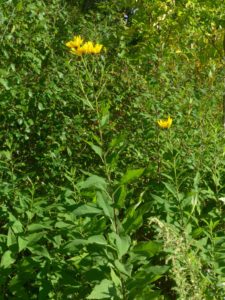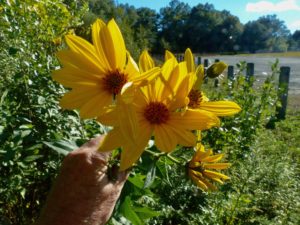Jerusalem Artichoke – 9/22/13
Observer: Paul Lauenstein
Observation Date: 9/22/13
Observation Time: 3:15 p.m.
Observation Location: Gavins Pond Road near soccer fields
Common Name: Jerusalem Artichoke
Scientific Name: Helianthus tuberosus
Comments: Before the arrival of Europeans, Native Americans cultivated H. tuberosus as a food source. The tubers persist for years after being planted, so that the species expanded its range from central North America to the eastern and western regions. Early European colonists learned of this, and sent tubers back to Europe, where it became a popular crop and naturalized there. It later gradually fell into obscurity in North America, but attempts to market it commercially have been successful in the late 1900s and early 2000s.
The tuber contains about 2% protein, no oil, and little starch. It is rich in the carbohydrate inulin (8 to 13%), which is a polmer of the monosaccharide fructose. Tubers stored for any length of time convert their inulin into its component fructose. Jerusalem artichokes have an underlying sweet taste because of the fructose, which is about one and a half times as sweet as sucrose.
It has also been reported as a folk remedy for diabetes : since inulin is not assimilated in the intestine, it doesn’t cause a glycemic spike as potatoes would. Temperature variances have been shown to affect the amount of inulin the Jerusalem artichoke can produce. It makes less inulin in a colder region than when it is in a warmer region.
More Information: Wikipedia


